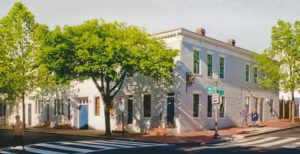Despite the COVID-19 pandemic’s drastic economic toll, alumni financial support for the university’s donation-dependent programs, such as the Georgetown Scholars Program (GSP), has remained relatively consistent with previous years.
The total dollar amount, however, masks deeper uncertainties in the fund’s sustainability and reliance on alumni generosity.
Giving patterns throughout the pandemic and earlier capital campaigns show a preference among alumni to donate to specific causes rather than a general university fund. A 2019 Council for Advancement and Support of Education (CASE) survey found restricted alumni donations are more commonly directed to student financial aid than funding from non-alumni sources. Alumni participation in GSP mentorship, a scholarship program that supports first-generation students, and involvement on the program’s executive board seems to support the data.
And this investment has allowed GSP to weather the latest economic storm. “We have been able to offer fall and spring grants that are above previous grant funding to our GSP students and we expect to be able to offer support to our students this 2021 summer,” GSP director Missy Foy wrote in an email to the Voice.
A recent report tracked donation rates at 104 advancement programs in the U.S. and Canada from the advent of the pandemic through the end of 2020. Findings indicated over half of institutions saw fundraising revenue losses, while more than a quarter reported declines over 30 percent.
“GSP’s experience during the pandemic has been no different from other philanthropically supported organizations,” Foy wrote. “But our overall trend remains strong, with total dollars raised for the Necessity Fund at or above the same levels in previous years.”
In Georgetown’s case, however, alumni donations earmarked for specific purposes may have helped financial aid recover from the general blow to university resources. “We have also seen significant support for our two pandemic priorities: University-wide financial aid, and COVID-19 response and resilience,” a university spokesperson wrote in an email to the Voice.
Donation levels may not have seen a sharp decline, but they do not stack up to other elite U.S. universities. A 2016 study found only 12 percent of graduated Hoyas give back in the form of donations, based on a three-year average. The top three rates in the study were 53, 51, and 47 percent—Wellesley, Williams, and Princeton respectively. CASE data show, however, that alumni comprise nearly a third of total giving to Georgetown, but the university only solicits a third of alumni for donations, based on an average of the 2019 and 2020 fiscal years. The university’s comparatively small endowment also puts it around 60th place in wealth, limiting opportunities for scholarship and financial aid initiatives.
The deficit has impacts beyond funding for on-campus programs and extends to admissions and recruitment. “We overachieve primarily because Georgetown has some natural assets, obviously the location is one and the Jesuit social justice pull is a big part of it,” Dean of Admissions Charles Deacon (COL ’64, MA ’69) said—assets which counterbalance the financial disadvantage Georgetown faces against its competitors.
“There’s no question that scholarship is critical. The university had to spend a lot more money on scholarship this year, and we’re need-blind and ‘meet full need,’ and they intend to keep doing that, but it’s costing a lot,” he said.
GSP’s fundraising history has been a particular success since its inception in 2004. Now, staff and administrators are looking for ways to ensure its progress carries forward in the long-term, a challenge only growing as a result of low alumni participation rates, the global health crisis, and the university’s short history of institutional advancement efforts.
Deacon was part of a core group that pushed for greater scholarship funding in the early 2000s, an initiative that led to the creation of the GSP. As part of a larger movement among universities to reduce and eliminate student loans at the time, Georgetown’s outgoing Advancement director tasked Deacon and Dean Patricia McWade with imagining a scholarship program for the upcoming fundraising campaign. The 1789 Scholarships were the beginnings of that effort, and in 2004, a pilot program was launched that prompted alumni reunion class leaders and their classmates to commit to five-year pledges.
In the first year, the initiative raised enough money to enroll 50 new students eligible for student loan support. The numbers would grow over the next few years into the 100s, and today, GSP serves roughly 650 undergraduate students. “There was pretty much a consensus that the lowest-income students who have the hardest time with loans should get the priority,” Deacon said. “We discovered in working with the students that the vast majority were first-generation college-bound students.”
A first-generation college student himself, Deacon identified a further need: namely, getting students on campus was not enough to support them through their time at Georgetown. Class leaders in the initial round of fundraising sought ways to provide more comprehensive support to low-income and first-generation beneficiaries of the 1789 Scholarships. In a move away from current-use fundraising measures, designed to be raised and spent in short order, alumni, administrators, and staff created an office to offer programming for scholarship students on the Hilltop. Foy, then an admissions officer under Deacon and on financial aid staff, ran the new GSP support network.
In the years since, GSP has built on its founding mission to provide additional services. “Necessity Fund microgrants, help students cover unexpected expenses that can put a strain on their finances,” Foy wrote. The program also offers alumni mentorship, and in 2018, launched the course “Mastering the Hidden Curriculum (UNXD-050), which centers questions of first-generation student identity and necessary skills for success at a university like Georgetown.
In a book borrowing a similar title, The Hidden Curriculum, author Rachel Gable interviewed and followed 91 first-generation and 35 continuing-generation college students at Georgetown and Harvard between 2012 and 2016. “The GSP has become an integral part of the larger Georgetown community, standing alongside other well-established programs,” Gable wrote, citing the Community Scholars Program and the Center for Multicultural Equity and Access.
But funding for scholarship and financial aid programs faces competition even within the university, mostly from campus improvement projects. With many fundraising efforts going toward brick and mortar projects, programs like GSP have found ways to reduce their strain on the university operating budget.
Part of the university’s fundraising challenges stems from a late start to institutional advancement. Several contributing factors exacerbated the difficulty Georgetown’s late entry to the fundraising race poses, including former Jesuit community funding, the imperative to develop a larger residential campus, and prior financial crises. Not until the 1970s and ’80s—Deacon assumed his position as dean in 1972—did the university embark on larger capital funding projects.
Under President Leo J. O’Donovan, whose tenure lasted from 1989 to 2001, Georgetown’s endowment nearly tripled. To commemorate the university’s bicentennial, O’Donovan announced an ambitious billion-dollar Third Century Campaign, which reached completion in 2003 and immediately preceded the push for greater scholarship and financial aid fundraising.
As part of Deacon’s own 2014 reunion, his class raised money for a $25 million endowment, which generates interest to help fund GSP staff, programming, and the Necessity Fund. Following five years of pledges and national campaigning, the endowment finally achieved its goal.
“To the extent that we met our goal, we were successful, but to the extent that the goal needed to be larger—that’s what we’re coping with now,” Deacon added, cognizant of the current economic context.
Nevertheless, the endowment provided much-needed stability to GSP’s funding structure over the past year. “In times like now, when there’s big financial crises, that money is protected to support the students,” he said.





